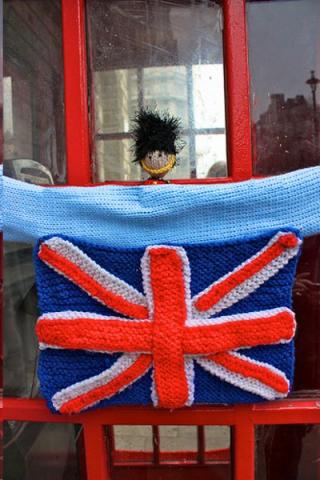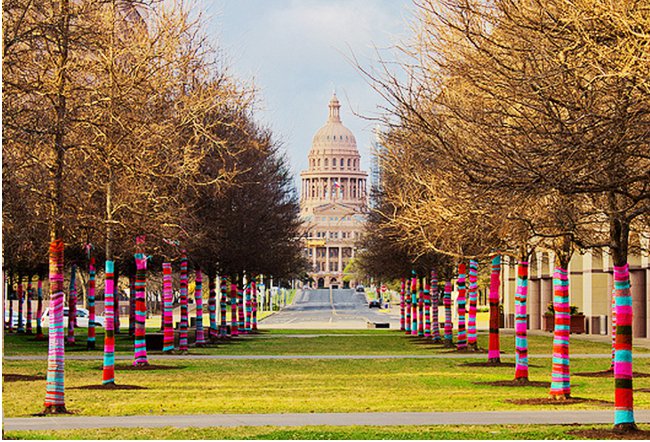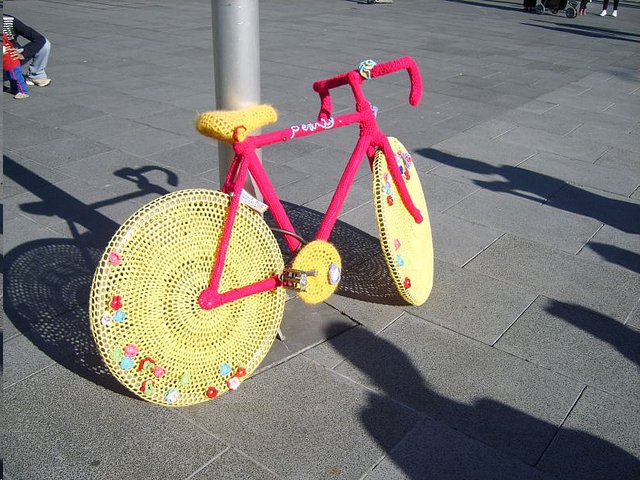The Yarn Bombing Movement Hits the Streets

Wild and woolly knit graffiti puts the art back in craft
Yarn bombing, yarnstorming, knit graffiti, guerilla knitting, urban knitting—regardless of the name it goes by, the art form is unmistakable. Colorful knit and crocheted materials have been popping up in urban spaces all over the world, as tree cozies, pole warmers, statue scarves and numerous other decorations. Bicycles have been bound, cars covered and entire buildings blanketed with cleverly woven yarn pieces. This isn’t a quaint folk art tradition found in bucolic hamlets (although it happens there, too): fiber creations are being thrown up with regularity and purpose in the same busy cityscapes that showcase spray-painted murals and other graffiti. And make no mistake: yarn bombing is a new type of street art, often full of as much intricacy and artistic expression as a work by Banksy or Retna.
Knitting-as-public-art started appearing in the first decade of this century. Houston-based textile artist Magda Sayeg was decorating the door handles of her boutique with custom-made cozies in 2005. Since then, she has founded the yarn bombing collective Knitta Please, created numerous knit installations around the globe (including a yarn-bedecked bus in Mexico City) and even enjoyed a solo exhibition in Rome in 2010. The attention she brought to the art form earned her the title “mother of yarn bombing.” Shanon Schollian’s Stump Cozy project of 2002 predates Sayeg, but her knit decorations for clear-cut trees occurred in Oregon forests, not urban areas. The JafaGirls’ (aka Nancy Mellon and Corrine Bayraktaroglu) Knit Knot Tree in Yellow Springs, Ohio, popularized yarn bombs in the Midwest in 2008, while Knit the City began yarnstorming (a term the group popularized, preferring it to the violent undertones of “bomb”) London in 2009. Other knitting crews have set their needles to work from coast to coast and throughout Mexico, the UK, Taiwan and Europe.
According to Arzu Arda Kosar, yarn bombing’s recent popularity obscures a rich history of fiber as decoration that goes back centuries. “Decorating public elements with knit and fiber-based materials has existed long before now,” she explains. Kosar is a Los Angeles-based artist with a keen interest in street art and community-building projects, and the founder of the guerrilla knitting collective Yarn Bombing Los Angeles. “Growing up in Turkey, I remember being fascinated by the ancient tradition of wishing trees where colorful strips of fabric are tied into tree branches.” She also references the deeply rooted knitting tradition in Peru, “where people have been using knit or woven material to decorate their surroundings (private and public) for centuries.”

Historical background aside, yarn bombing is as varied and individual as any art. Many artists think of it as a reclaiming of public spaces that have become cold, sterile and unwelcome. Woolly embellishments add color and whimsy to abandoned cars, chain link fences, broken-down payphones, potholes, traffic barriers and other examples of urban blight. Sometimes the message is more political, as when a military tank gets swathed in an afghan, or a statue of a soldier suddenly wields a cozy-cloaked pistol. Urban knitting can also be about bringing a community together, as the Knit the Bridge project in Pittsburgh demonstrated. Dozens of volunteers as well as several organizations came together in August to cover the Andy Warhol Bridge from end to end in more than 500 blankets, afghans and other fiber panels—the largest yarn bombing installation in the United States thus far.
But even in its most provocative form, knit graffiti is a gentle nudge to contemplation rather than an angry outburst. Knitting and crochet are nearly synonymous with the warm and fuzzy. Cozy, warmer, granny: the very language we use to describe fiber materials evokes gentleness and comfort.
According to Knit the City founder Deadly Knitshade, speaking on the knit collective’s website (www.knitthecity.com) yarnstorms foment change “with a grin instead of a grimace, a whisper instead of a bellow.” Most yarn bombers are women, which should come as no surprise: fiber arts, in general, are associated with women and domesticity. Guerilla knitters play with this idea by bringing their home-spun craft (more on that idea in a bit) out into the world of street art, dominated by the masculine, the gritty, the confrontational. “In its seemingly odd juxtaposition of knitting and graffiti, often associated with opposing concepts such as female, granny, indoors, domestic, wholesome and soft versus male, enfant terrible, outdoors, public, underground and edgy, the practice of yarn bombing redefines both genres,” explains Kosar.

Threep Parlour, the alias for an artist who founded the knitting crew Yarn Bomb Ojai, states outright that yarn bombing is a “female street art.” She has always had an affinity for graffiti and murals, and was inspired by the work she saw in and around Los Angeles. But she says that she often didn’t feel welcome, as a woman, trying to participate in the street art scene. Yarn bombing became a way for her to express her artistic vision in a safe space. The women of Yarn Bomb Ojai (who range in age from mid-40s to late-60s) started anonymously stitching up the Ojai Valley, a small community about 80 miles north of Los Angeles, in the summer of 2012. For practitioners like Parlour, yarn bombing isn’t merely a revitalization of rundown urban spaces; it’s also a reclaiming of space by and for female artists.
When the knitting collective Yarn Bomb Los Angeles put up CAFAM Granny Squared this past spring, covering the Craft and Folk Art Museum with hundreds of knit and crocheted pieces, several ideas pulled from the yarn bombing phenomenon were simultaneously being expressed. Janet Owen Driggs in her excellent article, “Unraveling the CAFAM Yarn Bomb,” published on the KCET website (www.kcet.org) notes the tension between high and low art at which urban knitting tugs. CAFAM’s building stands out on Museum Row as a charming, relatively small dormer-windowed structure dwarfed by its more contemporary neighbors, including the modernist monolith Los Angeles County Museum of Art. Covering this dollhouse-like edifice in vibrantly hued string begs a comparison to Pop Art, and “Just as Pop Art used the imagery and aesthetics of popular culture to challenge the traditions of fine art, YBLA is using the materials and methodologies of popular craft to mount a similar assault.”
“Popular” is an apt choice of words: knitters from all walks of life, in 49 states and 25 countries, donated some 7500 granny squares to the project. YBLA members carefully arranged the pieces into images that explored color, line and form in sophisticated ways, challenging the notion that art (aesthetics, the product of genius, transcending ordinary life) and craft (utilitarian, common, created by technicians rather than artists) occupy separate spheres.
This is an important distinction, as many artistic endeavors—including pottery, textiles, tapestry, folk art—labeled “craft” are automatically assigned a lower status, and thus their practitioners are excluded from the fine arts by definition. As graffiti (itself another lowbrow art) became a vehicle of expression for young, urban, often African-American and Latino artists who had been marginalized by the art establishment, knit graffiti has become the medium of (largely) female crafters and street artists. Cheerful though the CAFAM installation may be, it’s also a bold statement about what art is, and who defines it.

One other important point about yarn bombing is worth exploring: its almost intentional impermanence. Unlike paint graffiti, knit graffiti doesn’t alter or damage the objects on which it is placed, and removal is as easy as a scissor snip. When yarn bombers dismantle an installation, they tend to reuse the materials (frequently already recycled from old knitting projects, discarded sweaters, thrift-store afghans etc.) for other art projects or turn them into blankets and other objects donated to charity. Sometimes yarnstorms are simply taken down or stolen by unknown individuals. Parlour recalls the fate of one of Yarn Bomb Ojai’s carefully composed fabrications. “We did a beautiful pole with Matilija poppies and the next day, they were just gone. We throw our art out there into the world, and then sometimes it disappears. Nothing lasts in life. There’s something about that ephemeral quality that appeals to me.”
Perhaps the one common thread that ties together all types of street art, including yarn bombing, is that it’s a way of bringing art out of the elite realm of the museums and galleries and into the world at large, by and for the people. Knit graffiti makes art visible and accessible to the public, and also makes it seem doable. Anyone who can knit or crochet could potentially throw up a pole cozy or hang a pom-pom in a tree on the sidewalk.
Yarn bombing at its woolly heart is essentially democratic, and its “leaders” are happy to embrace the common knitter. Knit the City offers workshops throughout the UK, and Yarn Bombing Los Angeles holds monthly Stitch ‘n Bitch meetings. Those who prefer self-guided education can peruse Mandy Moore’s Yarn Bombing: The Art and Crochet of Knit Graffiti or Illiante Kalloniatis’s Art of Yarn Bombing: No Pattern Required. A simple online search will turn up several websites with yarn bombing patterns and practical tips. In the words of Deadly Knitshade, “Our squishy street art does many things. It takes a woolly hold on forgotten public spaces and gives them soul. It treats the whole world as an art gallery. It encourages others to bring their own city to life in ways only they can imagine.” Consider it a call to yarns.
Author Bio:
Nancy Lackey Shaffer is a contributing writer at Highbrow Magazine.
Photos: Knit the City; Magda Sayeg; Twilight Taggers (Flickr).




























































































































































































































































































































